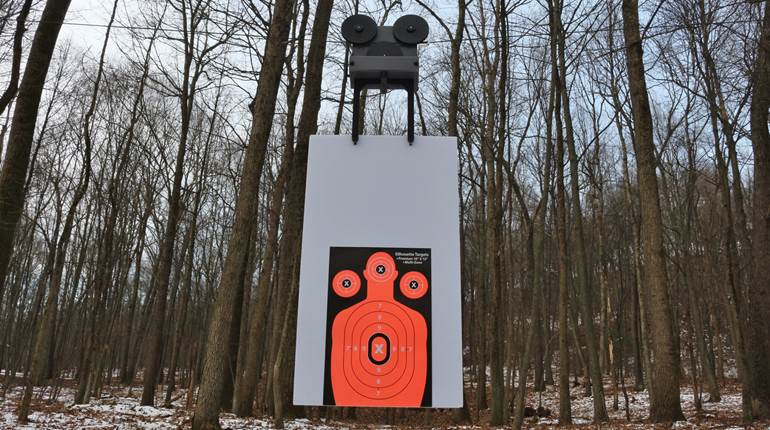
Cimarron’s 21st century reproduction of Colt’s Model of 1848 1st Model Dragoon revolver delivers 19th century power and accuracy. While blackpowder is an outdoor-only adventure, adding a Howell Conversion Cylinder allows for the shooting modern standard-pressure smokeless powder .45 Colt ammo at indoor ranges as well. These two-piece Howell six-shot cylinders have a backplate with six firing pins fitting over the chamber area and cost $250 in .45 Colt or .45 ACP. It was a drop-in and transitions between percussion and cartridge are seamless. A cylinder may need the attention of a gunsmith to fit properly, but mine didn’t. Howell offers them for many other cap-and-ball revolvers, too.
One point of note, though, is that the addition of a Howell conversion cylinder to any compatible blackpowder revolver technically constitutes the making of a modern firearm. This is legal to do, but if a revolver is sold with a conversion cylinder inside of it, then it must be treated like all other modern firearms and, depending on state laws, may require FFL transfers and background checks to sell.
While many of today’s pistoleros might think it a tremendous burden to disassemble the pistol to recharge the cylinder, it slows down the day and I find it very relaxing. The cost savings are great considering new American .45 Colt ammo runs north of $50 a box of 50 and even remanufactured ammo is north of $30 as a rule. Even if you reload, primers and powder are still scarce, so slowing down the shooting suppresses expense, keeps your trigger finger and eye sharp, and deploying a 4-lb. pistol provides a great workout!
 Blackpowder .45 Colt cartridges deliver power and accuracy. A 215-grain bullet over 35 grains of FFFg powder gave an average of 939 f.p.s.
Blackpowder .45 Colt cartridges deliver power and accuracy. A 215-grain bullet over 35 grains of FFFg powder gave an average of 939 f.p.s.
The big pistol has an interesting history. The revolver era began in earnest when the revolutionary belt-sized, five-shot Colt Paterson .36 arrived in 1836. It was slow to catch on, yet serious men like the Texas Rangers found the 10 shots a pair of them provided inestimable against the Comanche Indians, but it was complicated to load and wanting in power. Sales weren’t strong enough to keep Colt’s doors open and the company closed in 1842 after about 1,000 belt models were made.
When Texas Ranger Captain Samuel H. Walker was appointed a commission in the U.S. Mounted Rifles, he met with Sam Colt to discuss a new revolver leading to the behemoth Colt Walker in 1847. The Walker was our most powerful revolver until the .357 S&W Magnum came along, but it was literally “too much gun” and the smaller—but still powerful—1848 Dragoon model followed. It would remain the mainstay of our cavalry through three models and into the Civil War before deliveries of the handier 1860 Army and 1858 Remington began in earnest.
 Sometimes Old School is best. A lighter charge of 30 grains of FFFg under a swaged roundball lit by RWS No. 11 caps delivered this 2" group at 25 yards.
Sometimes Old School is best. A lighter charge of 30 grains of FFFg under a swaged roundball lit by RWS No. 11 caps delivered this 2" group at 25 yards.
Firearm evolution is interesting because it is often visually apparent. The three Dragoon models are such examples of this evolution in action. Most notable on the 1st Model is the oval cylinder notches and simple loading lever latch. The oval notches evolved into the square ones on the 2nd and 3rd Models with a runway scallop to guide the cylinder stop home when the revolver was cocked briskly. That technology is still in use today.
The Walker Colt’s lever was held by a spring and usually drops under recoil with even less than full-power loads. The 1st Model Dragoon added a simple spring catch under the barrel at the front. It still drops spontaneously under 40 grains of FFF powder and a 140-grain roundball, but doesn’t throttled back to 35 grains, or with the .45 Colt loads. The 2nd and 3rd Models have a more secure and improved easier-to-use latch.
 Post Civil War, private gunsmiths converted the big Dragoon models to accept cartridges. The Howell cylinder with a backplate allows us to easily do the same for use with standard pressure .45 Colt ammunition. Such a huge revolver must have been intimidating!
Post Civil War, private gunsmiths converted the big Dragoon models to accept cartridges. The Howell cylinder with a backplate allows us to easily do the same for use with standard pressure .45 Colt ammunition. Such a huge revolver must have been intimidating!
Before loading a percussion cylinder, I fire six caps with the muzzle pointed down. Puffs of dust at the muzzle show there is no oil clogging the nipples. When loading, I go from the flask to a powder measure to the chamber to isolate the flask. It’s a belt-and-suspenders rule. This isn’t a burden. I normally shoot a lighter charge than the flask throws.
Uberti tapers the chambers so that it gets tighter below the mouths (at least to the depth of my calipers) to help guard against the dreaded cross fire where more than one chamber goes off from the considerable fire out of the barrel/cylinder gap. The best insurance is a tight fitting ball, and another belt-and-suspenders approach includes an Ox-Yoke Wonder Wad over the powder, then grease over the ball. When commercial lubes got scarce several years back, I began using Crisco Shortening to keep the fouling soft as I did when I first started shooting these pistols back in the 1970s. I rarely use a wad.
 Half-cock the hammer, drive the wedge loose and pull it to the stop screw, then use the loading lever to dislodge the barrel. Remove the cylinder and drop in five cartridges. Place the backplate over the cylinder. The pin on the cylinder is a tight fit in the backplate, so keep it level to prevent binding. Reinstall with the empty chamber just to the left of the hammer (note the slots in the cylinder so you can visually see the rims). Slide on the barrel and snug the wedge. Be sure you lower the hammer on an empty chamber if you are holstering.
Half-cock the hammer, drive the wedge loose and pull it to the stop screw, then use the loading lever to dislodge the barrel. Remove the cylinder and drop in five cartridges. Place the backplate over the cylinder. The pin on the cylinder is a tight fit in the backplate, so keep it level to prevent binding. Reinstall with the empty chamber just to the left of the hammer (note the slots in the cylinder so you can visually see the rims). Slide on the barrel and snug the wedge. Be sure you lower the hammer on an empty chamber if you are holstering.
You’ll need some specialized tools to run these guns. Necessary for the percussion cylinder are a nipple wrench, wedge driver, small mallet and good screwdrivers. The wedge driver, mallet and screwdrivers are all that’s necessary for the cartridge cylinder. The wedge keeping the barrel in place is tapered, so don’t hammer it in or you’ll prematurely widen the barrel’s slot. You’ll be removing it to reload the cartridge cylinder every five shots, so just tap it snug.
The Howell .45 Colt cylinder has small slots so you can just see the rims with the backplate installed. After assembling it with five rounds, place the empty chamber just to the left of the half-cocked hammer. When you install the barrel and tighten the wedge, fully cock the hammer. If you’ve done it right, you’ll lower the hammer over the empty slot. The “window” in the cylinder helps ensure you did.
 Some tools vital to the care and feeding of the percussion cylinder include (from top, clockwise) a mallet, a powder measure, a nipple wrench and a brass wedge driver. All are helpful and the mallet and wedge driver double for the cartridge cylinder. Note the pin on the cylinder at 10 o’clock. It fits a mortise in the hammer to lock the cylinder between the nipples so all six chambers can be loaded. Better to load five and lower the hammer over an empty chamber.
Some tools vital to the care and feeding of the percussion cylinder include (from top, clockwise) a mallet, a powder measure, a nipple wrench and a brass wedge driver. All are helpful and the mallet and wedge driver double for the cartridge cylinder. Note the pin on the cylinder at 10 o’clock. It fits a mortise in the hammer to lock the cylinder between the nipples so all six chambers can be loaded. Better to load five and lower the hammer over an empty chamber.
Several loads were tried, and a .45 Colt handload with a 215-grain roundnose lead bullet over 35 grains of FFFg black was the most powerful averaging 939 f.p.s. and delivering a decent 3.5" group at 25 yards. A 6.3-grain load with Trail Boss under the same bullet averaged a mild 611 f.p.s., but was least accurate. A 5.8-grain load of Hodgdon Tite Group under a 250-grain lead bullet delivered accuracy similar to the black powder one and averaged 765 f.p.s.
The most accurate load delivered a 2", 25-yard group in the percussion cylinder with the simple store-bought Hornady swaged roundball over 30 grains of FFFg Swiss powder lit with a RWS percussion cap. Sometimes Old School rules.
 The Howell conversion cylinders come in many sizes. Next to the Model 1848 Dragoon is an 1849 Wells Fargo Model sporting a cylinder in .32 S&W. It’s equally as much fun, but ammo has not only been scarce but expensive, so taking half a day to shoot a box appeals to my cheap side!
The Howell conversion cylinders come in many sizes. Next to the Model 1848 Dragoon is an 1849 Wells Fargo Model sporting a cylinder in .32 S&W. It’s equally as much fun, but ammo has not only been scarce but expensive, so taking half a day to shoot a box appeals to my cheap side!
Be sure you have a well-fitting screwdriver set along with you! Brownells has them. During the shooting, almost all the screws needed tightening, and you’ll need a few differently sized bits. When shooting blackpowder, a wet patch or two followed by a dry one every five rounds keeps my gun shooting accurately. For cleaning at the range, I prefer Birchwood Casey No. 77 solvent. At home, hot water and Dawn Dish Detergent are fast and cheap for both gun and brass (decap the brass first!). Shooter’s Choice FP-10 is my oil of choice. ProShot pipe cleaners help clean and dry the nipples. There’s another good reason to use a conversion cylinder. Even shooting blackpowder cartridges, clean-up takes half the time, but shooting loose powder and ball gives you a better appreciation of what our forebears faced.
Cimarron Firearms 1st Model Dragoon Specifications
Action Type: single-action revolver
Caliber: .44
Capacity: six
Barrel Length: 7.5"
Overall Length: 14"
Height: 5.38"
Width: 1.87"
Weight: 64.05 ozs.
Sights: fixed; blade front, notch rear
Trigger: 3-lb., 4.8-oz. pull
MSRP: $543
Conversion Cylinder: Howell Arms; $250





































